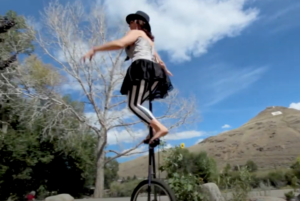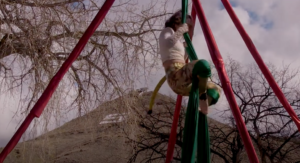At the Salida Colorado Circus School, hula hooping emerges as a vibrant and engaging discipline that captivates both novices and seasoned performers alike. This unique art form blends athleticism with creativity, offering participants an opportunity to explore dynamic movements and enhance their coordination. The school’s hula hooping classes are designed to accommodate various skill levels, providing personalized instruction and fostering a supportive environment where individuals can develop their technique and express their artistic flair.
Salida Circus School
 Participants at the Salida Colorado Circus School benefit from expert guidance that emphasizes both foundational skills and advanced tricks, ensuring a comprehensive learning experience. The school’s setting, nestled in the picturesque town of Salida, adds an extra layer of charm and inspiration, with its scenic landscapes complementing the fluid, rhythmic nature of hula hooping. In addition to honing their physical skills, students often find a sense of community and camaraderie within the school, as they share their passion for circus arts and collaborate in performances and workshops.
Participants at the Salida Colorado Circus School benefit from expert guidance that emphasizes both foundational skills and advanced tricks, ensuring a comprehensive learning experience. The school’s setting, nestled in the picturesque town of Salida, adds an extra layer of charm and inspiration, with its scenic landscapes complementing the fluid, rhythmic nature of hula hooping. In addition to honing their physical skills, students often find a sense of community and camaraderie within the school, as they share their passion for circus arts and collaborate in performances and workshops.
Overall, hula hooping at the Salida Colorado Circus School is more than just an activity; it’s a celebration of movement, creativity, and connection. Whether one is drawn to the discipline for fitness, artistic expression, or social interaction, the school offers a welcoming space where the joy and artistry of hula hooping can truly flourish. For those looking to visit or tour the circus school the Mecca motel Colorado is a centrally located location to jump off from.
Hooping In Larger Circus
 Major circuses often elevate hula hooping to a breathtaking art form by pushing the boundaries of what can be achieved with this seemingly simple prop. Performers frequently employ a variety of techniques, including spinning, juggling, and incorporating the hoops into acrobatic stunts. The inclusion of hula hooping in these grand productions underscores its versatility and appeal, as it seamlessly integrates into the broader tapestry of circus acts. The vibrant energy and skill required for hula hooping make it a highlight in any circus lineup, captivating audiences with its blend of athleticism and artistry. Overall, hula hooping in major circuses continues to enchant and inspire, demonstrating its enduring charm and its role in the rich tradition of circus performance.
Major circuses often elevate hula hooping to a breathtaking art form by pushing the boundaries of what can be achieved with this seemingly simple prop. Performers frequently employ a variety of techniques, including spinning, juggling, and incorporating the hoops into acrobatic stunts. The inclusion of hula hooping in these grand productions underscores its versatility and appeal, as it seamlessly integrates into the broader tapestry of circus acts. The vibrant energy and skill required for hula hooping make it a highlight in any circus lineup, captivating audiences with its blend of athleticism and artistry. Overall, hula hooping in major circuses continues to enchant and inspire, demonstrating its enduring charm and its role in the rich tradition of circus performance.
Hulas Beginning Roots
The history of hula hooping is a rich tapestry that stretches across centuries and continents, evolving from ancient traditions to a global phenomenon. The origins of hooping can be traced back to ancient cultures where circular objects were used for various purposes. In ancient Egypt, Greece, and Rome, people used hoops made from materials such as wood, metal, and vines for physical exercise, play, and ceremonial rituals. These early forms of hooping were not only a form of entertainment but also a method of promoting physical fitness and flexibility.
The modern hula hooping craze began in the mid-20th century, rooted in a revival of interest in traditional hooping practices. In the 1950s, the American toy company Wham-O popularized the hula hoop with the introduction of its plastic version, which became an instant sensation. Named after the Hawaiian hula dance due to the hoop’s similarity to the hip movements of the dance, the hula hoop quickly became a cultural icon. Its popularity surged as children and adults alike embraced it as a fun and challenging pastime.
The 1960s and 1970s saw the hula hoop become a symbol of the playful, free-spirited ethos of the era, with hooping being featured in television shows and advertising. In the decades that followed, the hula hoop fell in and out of fashion, but its resurgence in the late 1990s and early 2000s marked a new chapter in its history. The rise of hoop dance, an art form combining hooping with dance, acrobatics, and performance, contributed to a renewed interest in the hoop. This modern revival highlighted the hoop’s versatility, transforming it from a simple toy into a sophisticated tool for artistic expression and physical fitness.
Today, hula hooping enjoys global popularity as both a recreational activity and a serious art form. It is celebrated in various contexts, from circus performances and dance routines to fitness classes and competitive events. The hula hoop’s journey from ancient traditions to contemporary culture reflects its enduring appeal and adaptability, making it a timeless and versatile element of human play and creativity.